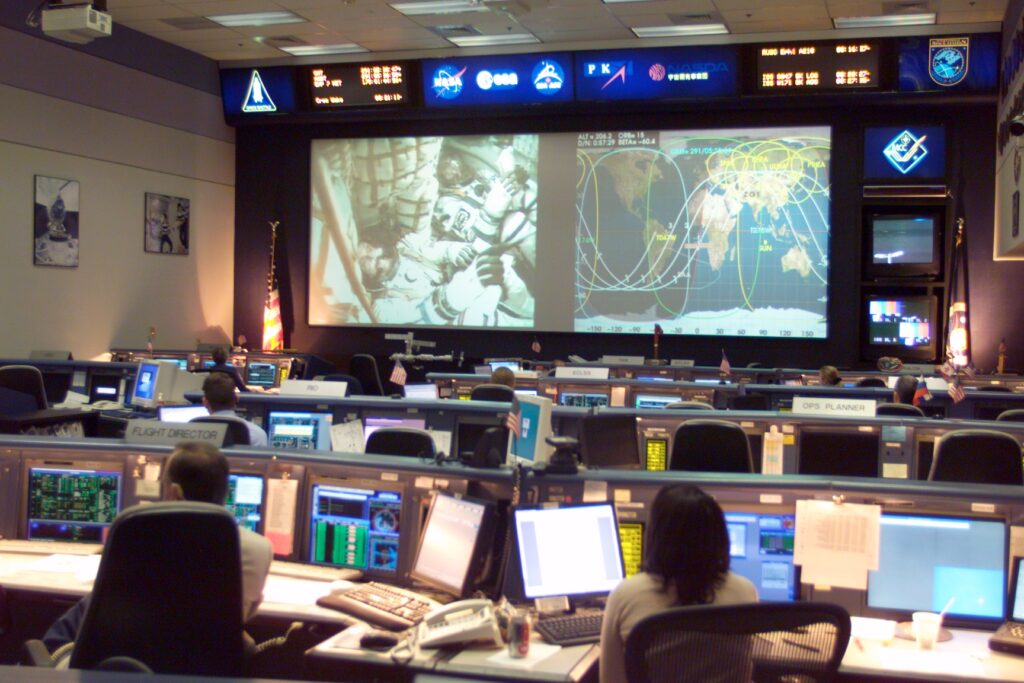Here at Optalert, we are proud to put our name alongside some of the most important research facilities in the world, and to add to that impressive list, Optalert’s technology has been used to study the alertness levels of NASA’s Mission Controllers monitoring the International Space Station. Information about the research and the results follows.

FATIGUE COUNTERMEASURE PROGRAM IMPROVES ALERTNESS AND PERFORMANCE IN OPERATIONAL FLIGHT CONTROLLERS
Laura K. Barger, PhD1,2; Jason P. Sullivan, BS1; MS; Steven W. Lockley, PhD1,2; Charles A. Czeisler, PhD, MD1,2
1Division of Sleep Medicine, Brigham and Women’s Hospital, Boston, 2Division of Sleep Medicine, Harvard Medical School, Boston
Spaceflight operations on the International Space Station (ISS) depends on the support of Mission Control at the NASA Johnson Space Center – hence, it is essential flight controllers remain alert and maintain high levels of cognitive function while operating and monitoring complex, technical equipment.
To support missions, flight controllers are often required to work overnight (Orbit 1) shifts. Acute and chronic sleep deprivation, circadian misalignment and consequently fatigue are commonly associated with overnight shifts.
In this study, we evaluated the feasibility, acceptability and efficacy of fatigue countermeasures for flight controllers. Specifically, we tested (1) the feasibility of creating an experimental break room (EBR) outfitted with blue-enriched light and exercise equipment for flight controllers to use during overnight shifts; (2) the acceptability of scheduling flight controllers for two 20-minute breaks to use the EBR during overnight shifts; (3) and the efficacy of the EBR by comparing alertness and performance of flight controllers during overnight shifts when they had access to the EBR to the alertness and performance of those same controller during overnight shifts when they did not have access to the shorter-wavelength light exposure and exercise in the EBR. We additionally evaluated alertness on the commute to and from Orbit 1 shifts.
We enrolled 17 flight controllers and 3 flight directors (9F, 33.3±8.0 years [mean ± SD], range 25-50 years) selected from the seven International Space Station Mission Control consoles regularly staffed for Orbit1 operations (Flight, OPS Planning, ADCO, SPARTAN, ETHOS, CRONUS, Ground Control). Using a randomized, crossover design, each participant was scheduled to work two blocks (4-7 days each) of Orbit 1 shifts during the study, one in the experimental condition and one in the control condition.
During the experimental condition, controllers were encouraged to visit the EBR once before the shift, twice during scheduled breaks during the shift and following the Orbit 1 shift. The EBR provided subjects with passive exposure to blue-enriched fluorescent lamps (Sylvania Octron Skywhite XP ECO, 8000K) installed in existing ceiling fixtures. In addition, subjects were encouraged to exercise on treadmills or stationary bikes located in the room (10 minute bouts, not to exceed more than 65% maximum heart rate). The controllers were instructed to continue their normal routines during the control block.
The controllers completed Visual Analog Scales and a 5-minute Psychomotor Vigilance Task before, twice during and following each Orbit1 shift. They also wore actigraphs to monitor sleep and completed daily work/sleep logs.
All subjects completed drive diaries following each commute and a subset of the subjects (n=11) wore Optalert drowsiness monitoring glasses on commutes to and from work to objectively monitor fatigue. A mixed model with repeated measures was used to compare data between the control and experimental Orbit 1 shifts. A paired t-test was used to compare drowsiness between commutes to and from work.
Controllers reported being significantly more alert (p<0.001) and the 10% slowest response times on the PVT were significantly faster (p < 0.05) during Orbit 1 shifts with access to the EBR, as compared to control Orbit 1 shifts. In preliminary analysis of Optalert data (n=5), controllers measured higher on the Johns Drowsiness Scale on the commute following Orbit 1 shifts as compared to the commute to work (p<0.05).
The data gathered from this study may inform Mission Operations Directorate about feasible, acceptable and effective countermeasures to improve the alertness, performance and safety of flight controllers scheduled to work overnight Orbit1 shifts.
NASA Human Research Program Investigators’ Workshop (2014) 3268.pdf


